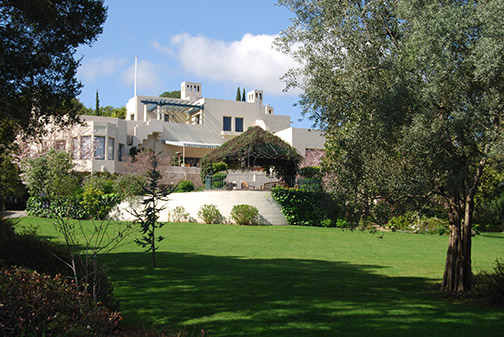 Palo Alto Stanford Heritage
Palo Alto Stanford Heritage 
Cresting San Juan Hill on the Stanford campus is the Hoover House, designed by Lou Henry Hoover, wife of the 31st President of the United States. Built between 1919 and 1920, it was the family’s only permanent residence. The Hoovers always considered it “home” though they lived there only sporadically: before leaving for Washington when Herbert served as Secretary of Commerce in 1921–28; when Hoover awaited the victorious Presidential election returns in 1928; when he lost the election to Franklin Delano Roosevelt. Longer periods of occupancy occurred from 1932 until Lou’s death in 1944.
Both Hoovers were born in 1874 in Iowa, both graduated from Stanford and both were Geology majors. Married in 1899, their ties to Stanford were strong despite sojourns in China, Ceylon, Burma, Siberia, Australia, Egypt, Japan, England and most of Europe. It is appropriate, then, that the architecture of Lou’s house is in the International style.
Planning for the house coincided with Herbert’s highly praised and publicized role in European relief efforts for 33 million displaced and starving victims of World War I. In 1917, the couple commissioned architect Louis Christian Mullgardt to design their house. When Mullgardt indiscreetly published a preliminary drawing of an elaborate house costing $50,000 in Architect and Engineer and in the San Francisco Examiner, he was fired. Although Mullgardt was a distinguished architect who personally helped Herbert’s war relief efforts by designing posters, the Hoovers felt that such publicity would be dimly viewed by the public in a time of wartime austerity and would harm Herbert’s reputation. The couple then asked Arthur B. Clark, a Stanford art professor, neighbor, friend, and freelance architect to design their house. Clark accepted on the condition that Lou design the house herself and that he and his son, Birge, who would return from military service in 1919, serve in an advisory capacity. Charles Davis, who had worked for Willis Polk and had drawn up the plans for Filoli, was brought in as the architectural draftsman. In his memoirs, Birge Clark notes that Davis “was in awe of Lou, whom he regarded very highly…saying that she was a unique client.” The arrangement with the Clarks was ideal for Lou as she would play the major role in producing the design. Lou sketched plans and elevations. Should anyone suggest that her architectural ideas weren’t being done, she would calmly respond “Well, it’s time someone did them.” Dare Stark, Lou’s private secretary commented that “The lady (Lou’s nickname with her staff) is occupied these days correcting Mr. Clark’s plans every time he draws them.”
In order to minimize ostentation, the large, rambling International style house was built on a hillside site. It seems to disappear into the slope of San Juan Hill, thus making the exterior appear smaller than its 5,000 square feet. Irregular in shape, the house is built on a reinforced concrete slab foundation. Herbert’s contribution to the design was that it be fireproof and that the walls be made of hollow tiles. The Clarks believed that Lou’s design resembled the block-shaped houses she’d seen in Algeria although there also seem to be elements of Native American adobe style. The overall result is a radically modernistic look, called International, whose flat-roofed, whitewashed terraces could well be found in a Moorish hill town. The interior spaces with their carved oak moldings, fireplaces and leaded windows reflect the fact that entertaining was a huge part of the Hoovers’ life.
Designing a house is quite an accomplishment but it is only one of many in the life of Lou Henry Hoover. She was raised unconventionally by parents who taught her the social graces, introduced her to business issues and encouraged her love of physical exercise, sports and the great outdoors. At the age of 14, she wrote two essays: “Universal Suffrage” and “The Independent Girl.” Linguistically inclined, she was fluent in five languages. Her undergrad major in Geology bonded her to her husband as he made his fortune as a mining consultant. It also enabled her to collaborate with him on a prize–winning, Latin–to–English translation of the 1565 guide to mining and metallurgy called De Re Metallica. She summed up her world view in a 1923 speech to the League of Women Voters: “It is very possible to have both a home and a career in this modern age, as we are released from so many of the burdens our grandmothers and great–grandmothers had to bear.” Lou’s position was obviously more privileged than the average woman’s. Yet, she used her intelligence, charm, diplomacy and boundless energy to encourage all women. Less known than her leadership in the Girl Scouts of America was her membership and active participation in the National Federation of Women’s Clubs, the National P.T. A., the League of Women Voters, the International Women’s Peace Conference and the National Amateur Athletics Association for Women.
In a fitting tribute to the woman who designed it, Herbert Hoover donated the Lou Henry Hoover House to Stanford in 1944. Upon settling her estate, even her husband was astonished by her altruism, stating that Lou had helped the education “of a multitude of boys and girls.”©
PAST, November 22, 2013
E-mail us at either webmaster@pastheritage.org or president@pastheritage.org.
![]() Palo Alto Stanford Heritage—Dedicated to the preservation of Palo Alto's historic buildings.
Palo Alto Stanford Heritage—Dedicated to the preservation of Palo Alto's historic buildings.
Copyright © 2015 Palo Alto Stanford Heritage. All rights reserved.